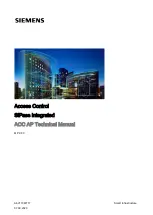
26
5. Check to make sure that all Slack Safety locks are
cleared and free. (See Fig. 13.1)
6. Continue pressing the raise button until the Cables get
taught and the lift starts to move.
7. Raise lift until the lift stops and lower until the Safeties
engage the Top Locking Position. Adjust each ladder so
that each Safety Lock rests on the corresponding Top Lock
Position. Then adjust each Cable Nut so that each Safety
Lock is ONE INCH (1”) above the Top Lock Position. The
Cable Nuts MUST be tightened until there is at least one
inch of threads protruding through the nut. (See Fig. 13.2)
Failure to do so could result in serious injury or death.
All cable nuts MUST be tightened on each end until there
is at least one inch of threads protruding through the nut.
Failure to do so could result in serious injury or death.
NOTE:
There will be initial stretching of the cables in the
beginning and/ or with increased loads. Adjust the
cables as outlined above a week after first use, then
every three to six months thereafter depending on usage
and/ or to compensate for stretch.
8. After connecting the air supply, press the PUSH
BUTTON AIR VALVE and check that all Safety Locks are
functioning properly. Lower the lift by pressing the push but-
ton air valve and Power Unit lowering valve simultaneously.
KEEP HANDS AND FEET CLEAR
. Remove hands
and feet from any moving parts. Keep feet clear of lift
when lowering. Avoid pinch points.
9. Check all MAIN SAFETY LOCKS to make sure they
move freely and spring back to the lock position when
released. Lubricate all SAFETY PIVOT points with WD-40
or equal.
10. Run the lift up and down a few times to insure that the
locks are engaging uniformly and that the safety release
mechanisms are functioning. Re-adjust if necessary.
STEP 14
(Anchoring The Columns)
1. Before proceeding, DOUBLE CHECK MEASURE-
MENTS and make certain that the bases of each column
are square and aligned with the chalk line. Raise the lift up
and down and make sure it operates properly at the locations
prescribed by the markings on the floor. (See Fig. 14.1)
2. Using the BASE PLATE on each column as a guide, drill
each anchor hole approximately 5” deep using a rotary hammer
drill and 3/ 4” concrete bit. (See Fig. 14.2)
Fig. 13.1
Fig. 13.2
Fig. 14.1
Fig. 14.2
IMPORTANT NOTE:
BendPak lifts are supplied with installation instruc-
tions and concrete fasteners meeting the criteria as
prescribed by the American National Standard “ Au-
tomotive Lifts - Safety Requirements for Construc-
tion, Testing, and Validation” ANSI/ ALI ALCTV-2011.
Lift buyers are responsible for any special regional
structural and/ or seismic anchoring requirements
specified by any other agencies and/ or codes such
as the Uniform Building Code (UBC) and/ or Interna-
tional Building Code (IBC).
Summary of Contents for HDS-18E
Page 24: ...24 ...
Page 30: ...30 30 OPTIONAL EQUIPMENT INSTALLATION ...
Page 42: ...42 ...
Page 43: ...43 ...
Page 44: ...44 ...
Page 45: ...45 ...
Page 46: ...46 ...
Page 47: ...47 ...
Page 48: ...48 ...
Page 49: ...49 ...
Page 50: ...50 ...
Page 51: ...51 ...
Page 52: ...52 ...
Page 53: ...53 ...
Page 54: ...54 ...
Page 55: ...55 ...
















































